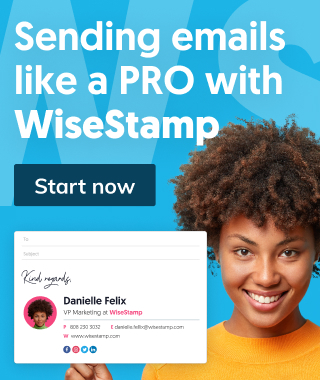What is Email Marketing: a starter guide (2023)
Email marketing is your direct line to your customers, clients and audience. Here is why every small business should leverage their email marketing.

Email marketing is considered to be one of the most cost-effective digital marketing channels for businesses and individuals. But to get the most out of your email campaigns, you need to build them strategically. Take the user-centric approach.
Get to know your recipients and segment your list to deliver relevant messages to the right people. Know when and how often they want to receive your emails. A strong subject line will grab their attention, while storytelling will inspire them to choose you over your competitors.
To start getting to know how all this is done and start growing your revenue through email marketing read on!
What is email marketing
Email Marketing is a digital marketing channel where marketers provide content and communicate with prospects via email. Email marketing campaigns are known to have one of the highest ROI of all marketing channels. Most successful businesses use email marketing because it gives them the opportunity to personalize their relationships with customers, increase overall brand awareness, and gain more conversions.
How to Build a Competitive Email Marketing Campaign
The number of your competitors investing in email marketing keeps growing, the way we do email marketing has changed. Today’s consumer expects a more personal approach to marketing emails. In other words, to engage your customers and convert them, you need to build highly targeted, data-backed email campaigns. Here are six essential tips for a competitive email marketing campaign.
1. Use Split Testing to Boost Clicks
If you’re torn between two awesome email marketing ideas, why not compare them?
You can always find new things to test, be it the images you use, the email design, subject lines, or the position of a CTA button in the body of the email.
As a starting point, compare different subject lines, as they dictate your open rates and click-through rates. For example, if you have two identical emails with different subject lines, your goal is to test which one has greater opens and use it in your future campaigns.
This is exactly what digital marketers love about split testing, as it gives them the opportunity to identify the tactics that work for them and focus on them in the future.
Additionally, you want to monitor the overall effectiveness of your email campaigns and their impact on your SEO efforts.
Choose the right metrics to track, such as the email:
- click-through rate
- conversion rate
- bounce rate
- email sharing rate
- list growth rate
- ROI
These are some of the most significant email marketing KPIs that indicate the effectiveness of your campaigns and help you track their performance and growth over time.
Most importantly, never observe your email campaigns in isolation. Instead, choose the right analytics tools that let you combine your email analytics tools with other digital marketing tools on one dashboard and create comprehensive SEO reports.
This way, you will be able to understand where your email campaign stands compared to other organic digital marketing channels and improve it to achieve greater results.
2. Write Powerful Subject Lines
Like I’ve already mentioned, a subject line is the nerve center of your email campaign. It helps you stick out in overcrowded inboxes and get users to open your message. Here are a few simple rules to follow when crafting a subject line:
- Like a headline of your blog post, email subject lines are here to grab people’s attention and inform them about what they will get once they open the email
- Make sure you personalize your subject lines by using a recipient’s name- it will result in a 29% boost over generic subject lines
- Keep it short, informative, and catchy
- Avoid using trigger-spam words that would send your email directly to the inbox.
3. Build a Strong Narrative around your Brand
Creating an attention-grabbing subject line is important. But, what happens once a user clicks on it and opens your email? Well, you need to keep them interested and encourage them to take the desired action.
This is where storytelling steps in. By creating an engaging and emotion-evoking story around your brand, products, and services, you will nurture stronger relationships with your potential customers.
Above all, not each email you send needs to be promotional. Use your emails to bring value to your target audience, inform them about the latest industry trends, and educate them. By not mentioning the product or service until the very end of your message, you will build trust with a recipient and convince them to buy from you without pitching to them.
Align your calls to action with your storytelling efforts, as well. For example, if you’re striving to build relationships with users instead of making sales directly, why not use your CTAs to guide them towards a relevant article on your blog or get them to download your latest guide?
4. Apply email marketing persuasion tactics
Amazon has spent as much as $6.5 billion on R&D in a single year. One of their key findings was that strategic email marketing is one of the most powerful ways to boost sales.
To really harness the power of email marketing, it’s not enough to just write something in mass and send it out, you need an email copy that’s persuasive, an email copy that entices your readers to act and buy. Here are 3 psychological tactics for boosting sales through email marketing.
I) Emphasize scarcity
You’ve probably received an email from a retailer offering you a deal with some sense of urgency or scarcity: “Limited time offer!”; “Only 2 in stock!”; “Act now!”
This tactic works, and there is even a psychological study explaining how the idea of scarcity influences people to add more value to an item or offer. In this particular study, people were offered jars with either 10 cookies or just 2 cookies; but, unbeknownst to the participants, both jars contained exactly the same type of cookie.
When asked which “type” of cookie the participants valued more, the clear winner was the jar that had only two. So, how does this relate to your email campaigns? Research shows that adding the idea of “scarcity” can automatically boost open rates by up to 39 percent.
You can create this by offering limited-time discounts, selling products that have limited availability, or by introducing offers that are only available for certain periods. No matter how you implement this sense of urgency and scarcity into your emails, it is likely to motivate your customers to act.
II) Tailor and target emails instead of “Batching and Blasting”
Dale Carnegie famously said that the sweetest sound to anyone is the sound of their name; in other words: Personalizing your emails is extremely important. And it’s not as much work as you might think. Luckily, there are lots of email service providers that enable you to automate emails yet still add a great deal of personalizing based on user activity, interests, and other unique attributes.
In fact, a core portion of Amazon’s recommendation engine—both on-site and in emails—relies on personalization. If Amazon were to remove personalization from its business model, it would likely cut its revenue in half.
That’s precisely why if you order a TV from Amazon in the morning, you can count on getting an email that same evening or the following day encouraging you to purchase a DVD player.
III) List the most expensive item first
Assuming you want to send an email promoting a series of products, do you show the more expensive product or the cheaper one first? If you’re like most people, you intuitively want to display the cheaper one first. However, this is often a classic mistake!
As psychology has repeatedly revealed, you would get significantly better results by displaying the more expensive product first.
In fact, intentionally including more expensive products is a proven way to give people a frame of reference for comparing prices, which leads to a boost in sales.
2 psychological concepts that explain this are “anchoring” and “the contrast effect.” Both concepts infer that we do not judge anything in a vacuum—instead, we judge one thing in comparison to another. So, your $299 handbag is not necessarily expensive—what matters is how many other handbags are… $29 or $2,999?
When selling expensive products through email, don’t be afraid to “anchor” them by first introducing more expensive products than the actual ones you want to sell.
When someone sees a product that costs $1,000, and then suddenly sees other similar products that cost $899—usually, it’s a sign of relief, as if they got a bargain, and it can be very good for boosting revenue.
5. Segment your List to Increase Engagement
Segmentation is an important part of your email marketing campaign, as it helps you personalize your marketing efforts and reach out to the right audiences with the right offers. And, stats back me up on that, showing that segmented email campaigns drive a 760% higher revenue.
Once a user signs up or makes a purchase, you can ask them to highlight their preferences. Ask them about their interests, needs, and content they would like to receive from you.
You can collect user information via chatbots on your site or social networks, by asking them about their preferences in your welcome emails, or even by having them complete a user profile on your site.
Based on the information you collect, create highly personalized email campaigns that would speak to different audience segments and keep them engaged.
6. Choose the Right Timing
Sending emails continually will engage your subscribers and increase their awareness of your brand. However, no one likes to be overwhelmed. The majority of users unsubscribe from email lists because they receive too many emails.
To avoid that, you should test your email lists to see how engaged your users are. You can even take your strategy to the next level, allowing recipients to choose how often they want to get your emails. This way, you will be able to understand their needs and ensure they stay engaged without boring them to death.
The Do’s and Don’ts of Email Marketing
We’ve sent out over one million cold emails, which have generated tens of millions in closed sales for our B2B. Today we would like to share with you the best-case practices we’ve learned, and how you can use them to effectively sell your product or service via email.
Though these work best when selling to other businesses, the principles can still be applied to any sales email you send.
DON’T Send Mass Emails
Another thing that most companies do – especially if they have a list of one or two thousand contacts to reach out to, is write what they think is an awesome template and “blast” it out to everyone on the list. Doing that is a fantastic way to get your domain marked as spam.
DO Research Each And Every Prospect
What works instead is to spend a minute or two researching each prospect.
Here’s how we break it down:
- Minute One: Review the client’s website and determine if they’re a good fit for your company. Do they have the right number of employees? Do they fit your buyer profile?
If not – don’t email them. - Minute Two: Social media. Time to get personal by looking at your specific contact’s Twitter account for something interesting that you two might have in common. For instance, if they mention a favorite football team in their bio you can write something like:
“Sorry about the Bucks performance last night…”Calling out personal details and customizing each email makes readers more likely to respond. I’ve even received thank you’s from people that weren’t interested in our service, solely talking about how great it was that we did research before emailing them.
Of course, individually researching each contact will take more time, especially if you’re new at it, but with enough practice eventually, you’ll know exactly what to look for and where to find it.
Don’t Introduce Yourself In The First Line
There are hundreds of articles online that detail how to write a good subject line, but what many of them miss is that the second line in an email is just as important for open rates. This is because most apps offer a preview of the first line, so be sure to make the most of it.
Originally we started our emails with “My name is Alex and I’m a business development guy from InspireBeats” starting that way led to much lower responses.
DO Use The First Line To Build Interest
The ultimate first sentence in an email is something that’s customized to a recipient, states how you found their site, and presents either a compliment or a business problem.
A great example:
“Found your site and am super impressed by your work for KFC. Also saw you were looking for new designers on AngelList and thought I might be able to help.”
That is a straightforward intro paragraph that will get your potential customers to read on.
DON’T Use Spammy Subject Lines
Okay, this is a big one. Think of your subject line as a sort of “barrier to entry” to your emails. If your subject line isn’t up to snuff, your open rate will inevitably suffer. And despite popular belief, clickbait-y subject lines will not score you points with subscribers. On the flip side, they might send you to the spam folder.
Instead, strive to craft punchy, personalized subject lines that pique your reader’s interest. Below are some good examples from the eCommerce space:
- “We don’t want to stress you out but…” (Firebox)
- “This is too sweet to pass up 🍭” (Chairish)
- “Future [Name]’s Favorite Trunks.” (Chubbies)
Considering that you have approximately 65 characters or so to work with, businesses need to be brief yet creative. If there’s one element of your emails to agonize over, it’s your subject line. Give it the attention it deserves when planning your campaigns.
Don’t Ignore Your Message Preview
Okay, this one’s easy to overlook. We just told you that your subject line should be one of your main points of focus, right? That said, don’t forget about your email preview (also known as a “second subject line”). This includes the initial line of copy in your messages that’ll show up prominently in a mobile inbox.
Previews matter because they serve as your readers’ “taste” before they click through. As highlighted by Litmus, truncated and typo-filled previews are a bad look for any brand:
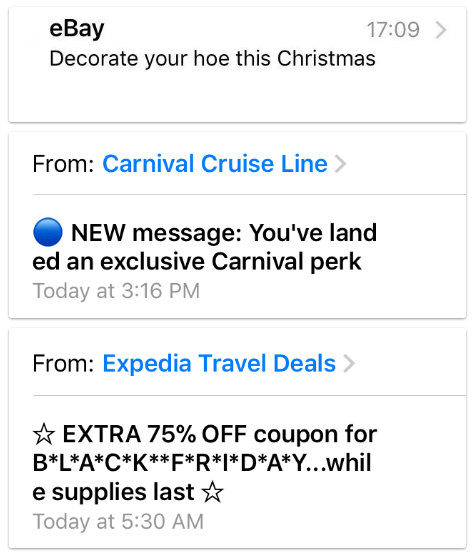
The “preview” piece of your message is valuable real estate, so don’t waste it or let it distract from your message. Granted your email marketing service doesn’t already provide a preview, you can use a tool like the aforementioned Litmus to make sure yours is on the up-and-up.
Don’t Complicate
When sending out follow-up emails, it’s easy to hand off the responsibility of responding to the recipient. For instance, I’ve seen emails that end with “If this sounds interesting, let me know.” or “I’d love to find a time to chat if this makes sense.”
The issue with these endings is that there is no pressure for the recipient to respond. Keep in mind that some of the potential customers you’re emailing receive hundreds of messages a day, and it’s up to you as a good salesperson to make their lives easier with a yes or no question.
Trying to Say Too Much Just Confuses Your Message
For starters, “less is more” when it comes to what you need to say. The ideal email length sits somewhere between 50 and 125 words. This might seem brief but makes perfect sense given the fact that today we’re dealing with so many busy readers on the go. The sooner you can get your point across, the better. Remember: your goal is to encourage a reply or click-through, not write a novel.
Here’s a shining example from Wistia of how a combination of brevity and imagery can get the job done via email.
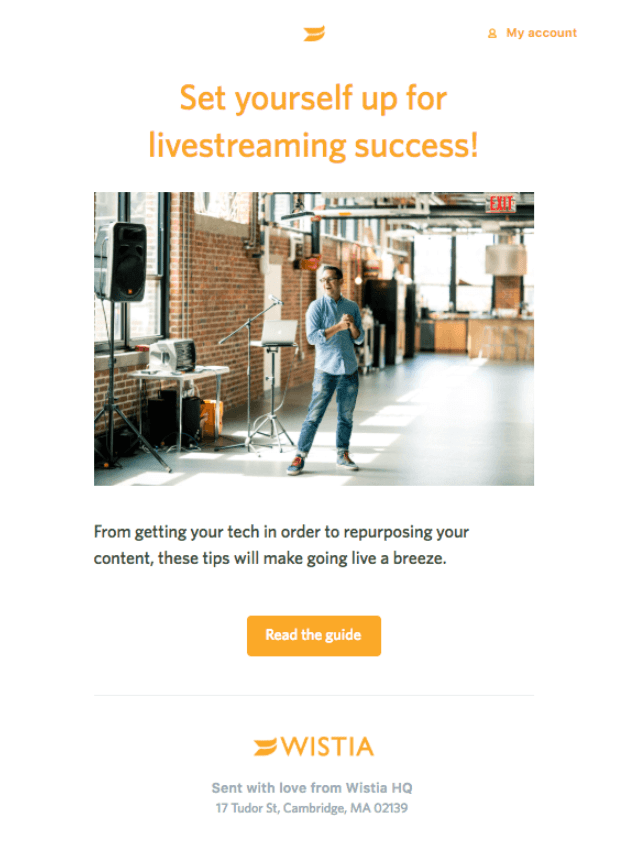
What if you’re primarily writing text-based messages and sales letters? No problem. The folks at Constant Contact provide a good example of a short-but-sweet marketing message that doesn’t overwhelm your readers.
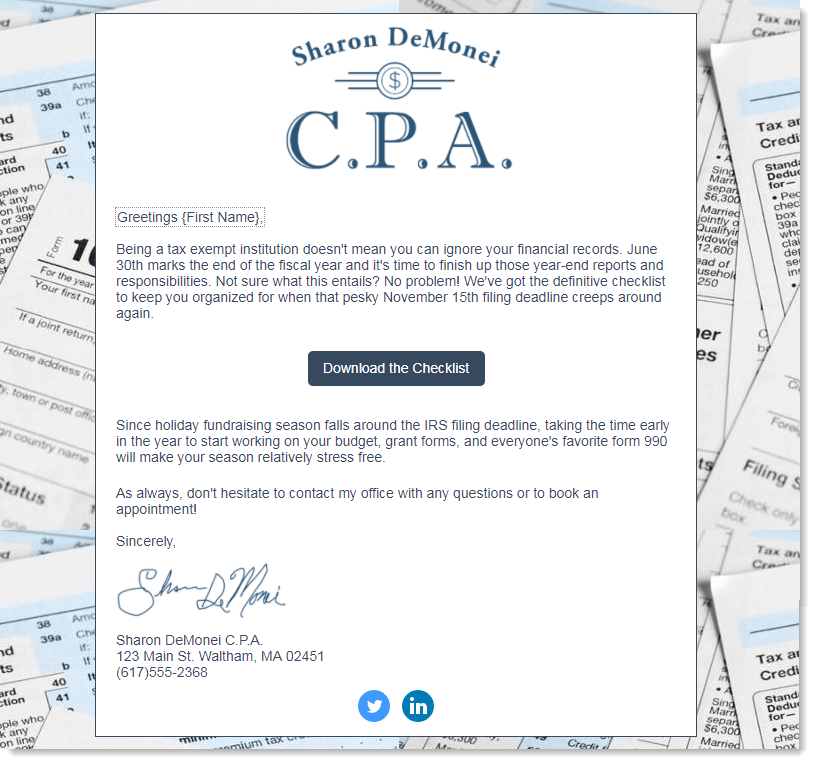
When in doubt, keep your messages and copy simple. Center around a single subject or action to stay focused and economical as possible in terms of your words.
DO Simplify
Here are a few questions that work great as conclusions to an email:
- “Does that sound interesting to you?”
- “Are you available for a call later this week?”
- “Would you mind if I send a free trial link?”
Don’t mislead
When sending out emails, you might hurt your reputation and trust with existing customers, causing them to ignore your messages or send you to spam.
To make sure you don’t get marked as spam, follow these simple rules:
- Don’t use misleading header information – The header information such as “From”, “To”, “Reply-To”, and the email address it was sent from, must identify the sender accurately.
- Don’t use deceptive subject lines – The subject line must accurately identify what the content is about.
- Tell recipients where you’re located – Your message must include a real physical postal address.
- Implement an “unsubscribe” button – It’s important to give your recipients the option to stop receiving emails from you.
DO Use a Professional Email
A professional email address (email@yourbrand.com) can help you increase the reputation of your business. Think about it, if you see an email and it says it’s from a business, but it ends in gmail.com instead of their domain name, does that inspire trust?
No, of course not. It’s the same with your business. The good thing is that website hosting providers offer professional email accounts for free with web hosting packages. Since you’re hosting your business website somewhere, get in touch with your hosting provider if you still don’t have a business email.
DON’T Give Up Too Soon
So you’ve sent out hundreds of emails, waited a few days, and only received a few responses back. Does this mean that the ones that haven’t responded are dead leads? Of course not!
DO Reach Out At Least 5-7 Times
What we’ve found is that it takes most prospects 5-7 “touchpoints” before they respond, because they’re so busy.
A sequence that works great for us is:
- Send the initial email
- Follow the recipient on Twitter
- Favorite or retweet a few posts by the recipient
- View their LinkedIn profile
- Send another email a few days later
- Connect to the email recipient on LinkedIn
If none of that works – you can always call the prospect. The best time we’ve found to call is within 5 minutes of them opening up your email.
The reason this works is that if your contact is checking their email it means they aren’t busy with other things. By reaching out at this moment your team has a much higher chance of connecting with the right person.
DON’T Use Too Much “I,” and Not Enough “You”
Finally, if you want to avoid sounding like a salesperson, you need to put your recipient first. This means emphasizing what’s in it for them rather than just hyping up yourself or what you’re trying to sell.
Especially in sales-based emails, it’s crucial to push benefit-driven language that pats your reader on the back. Your messages should empower readers to feel good and take action, not wonder whether they’re facing a bait-and-switch.
This email from Asana is a brilliant example of what we’re talking about. Note that the benefits of the email’s offer are sprinkled throughout, with no strings attached. If you can reach this level of persuasion and be positive with your own messages, you’re definitely on the right path.
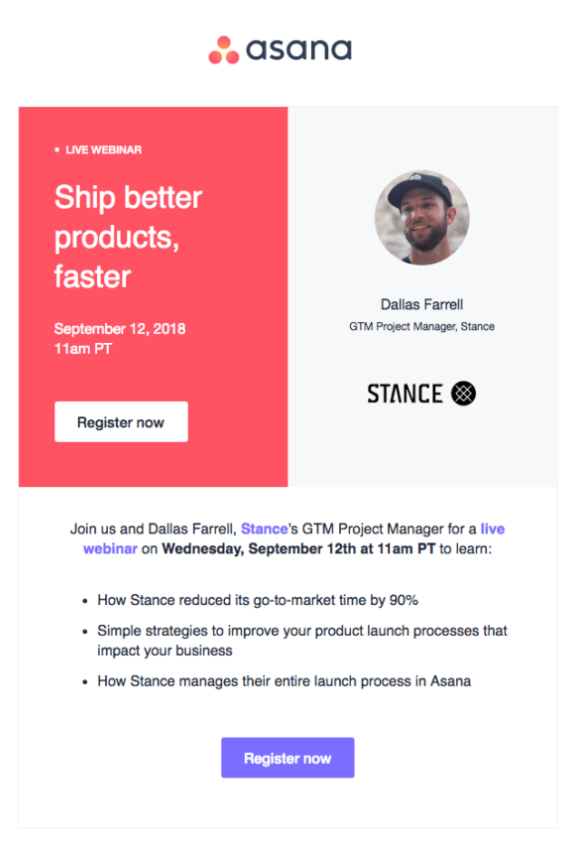
DO Conclude With Each Prospect
We have prospects that have been getting monthly emails for up to seven months in a row, some of whom end up buying. Also, be sure not to take delayed or negative answers personally. You’re one of the 100 people per day trying to get your prospect’s attention.
No email can guarantee they’ll buy anything, but using a system like this drastically increases your chances. There is always more to learn about email etiquette, so keep learning.
DON’T Stop Asking but DON’T ask too often
Another strategy we use with our higher lead gen plans at InspireBeats is to repeatedly follow up with prospects until we get a definitive answer. We keep going until they give us a yes or a no. The reason for this is if you did all the research we described earlier, and you’re sure everyone you reach out to is a good fit, eventually, the time will come when they need your service.
But for some marketers If they haven’t gotten a response, their gut reaction might be to start hammering your list with follow-up messages, But that would be a mistake. Although following up is totally fair-game, doing so to maximize engagement is often a balancing act.
How so? Well, pushing too hard could result in unsubscribes as people see you as a spammer. But by not sending enough messages, you could be hurting your bottom line or engagement rate.
This oft-cited study from MarketingSherpa sheds some light on the subject, noting that monthly to weekly emails are vastly preferred by readers.
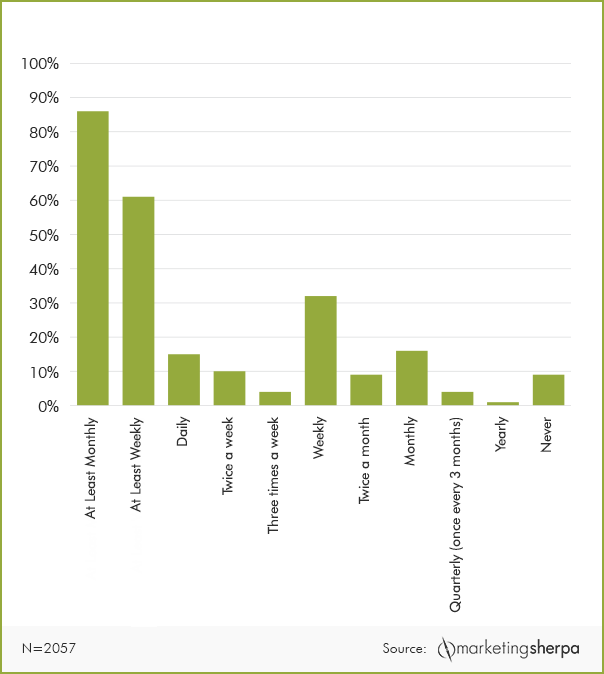
Although this study isn’t the be-all, end-all of frequency, it does support the idea that you can always ramp up your emails down the line rather than come off too strong upfront.
DO Leverage Your Email Signature for Email Signature Marketing
One of the least expensive and least known ways to promote your business and build your brand awareness is by leveraging your company email signatures. Most businesses, big or small, rely on email for most of their communication. This is why having your brand included in every email through your employees’ email signature is a powerful and cost-effective way to keep your brand top-of-mind.
Adding a CTA to your email signatures company-wide will allow you to promote your business goals through your everyday email correspondence, which can reach from the 10s to the 1000s each day. This will cost you hardly anything and will become a new channel for lead gen.
To create a company-wide branded signature you’ll need email signature management software. The WiseStamp Signature Manager is most likely your best option, and you can use it to give every employee a professional-looking company signature from a central dashboard. The tool also lets you set up and monitor email signature marketing campaigns, through CTA’s added directly in your company signature block.

DON’t Use Spam Words
Spam filters ensure that the recipient receives only genuine emails and nothing spam-related. But the problem is when businesses like to use words that spammers also use. Keywords like “50% off” or “100% free” are likely to deliver your email to the spam folder.
When running a small business email marketing campaign, there’s always the risk of spamming. This might not be intentional from your side, but certain words or sentences are caught by spam protection software. Other than that, there are a few more things that can get you on a blacklist.
Bought email lists go against the CAN-SPAM act and can get you reported for spam and placed on a blacklist. The main problem with this is sending a marketing email to people who haven’t subscribed to you.
You can use a tool like Mail Tester to check if your email could end up in the spam folder.
Words to Avoid When Sending Out an Email
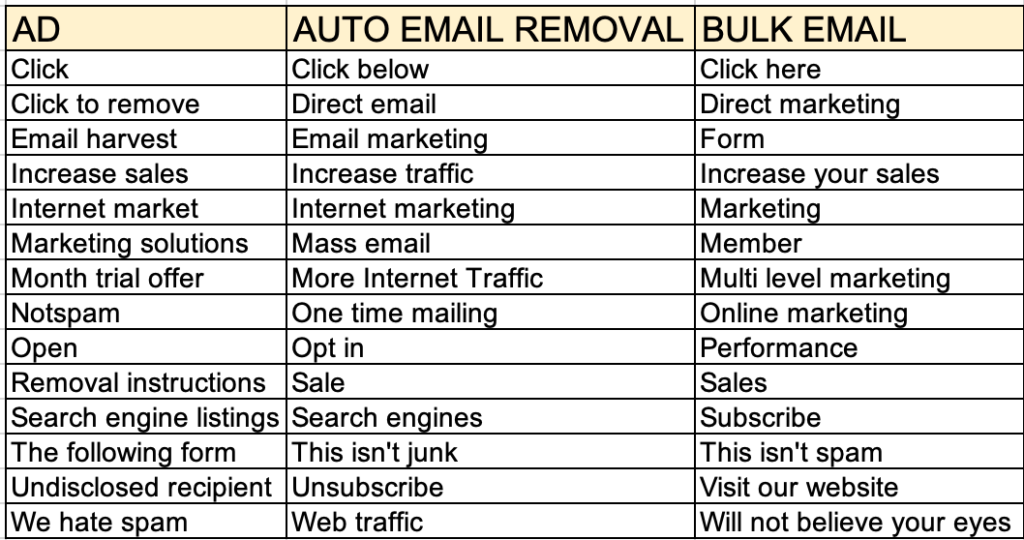
You need to minimize the use of these words as much as possible. It’s generally a good idea to restrict yourself to one high-spam keyword.
DON’T Stay At The Same Level
Cold emailing is a skill, which means that at the beginning your team is going to be bad at it. Our response rates are currently very high, but that’s a result of several years of experience. You now have the advantage of knowing what we didn’t. Use this system and make it your own.
The Advantages of Email Marketing
Apart from the insanely high ROI, there are a lot more benefits to small business email marketing. Here are 5 advantages that impact the business the most.
1. Building Credibility and Trust
People like to do business with companies they know and trust. This is the reason why iPhone users buy the new generation of iPhones and Samsung users do the same with Galaxy phones. Brand loyalty.
Now, you probably know that in order to build trust, your customers have to become more familiar with your brand. That’s mainly accomplished through marketing. Email is what you’re looking for.
Your new blog post, your next event, or just about any news considering your business, could be fitted in the email.
This is especially important since the first thing most people check when they wake up in the morning is their phone.
Imagine what could happen if your business is the first thing your customers think about in the morning.
2. Personalization and Compartmentalization
When you’re using other marketing methods, you can’t fully control the ad. Some platforms will allow you personalization, some will allow you to categorize, but not to this extent.
Business email marketing will enable you to compartmentalize different types of customers in different email groups. If you’ve got 6 products and all of them are different, this can be useful.
This is especially true for small business email marketing. A growing company has to compartmentalize in order to increase the open rate and reduce the unsubscribe rate.
3. Retargeting Emails to Specific Clients
Email marketing can be used to connect with clients in real-time with a marketing method called retargeting.
Retargeting might be the most powerful marketing method that involves showing ads, or in this case sending emails to people who’ve completed the desired action. This action can be a click, visit, add to cart, initiate checkout, or something else.
After the user has completed an action, retargeting is used to give them that last push (or a couple of pushes) to make them convert.
Tailoring is the perfect example: Let’s say you own an online store and a customer adds a product to the cart and leaves the website. If you have their email, you can automatically send them an email to remind them about finishing an order.
4. Takes Advantage of Impulse Buying
You can craft an email into a small landing page. This means that you can present your customer with a sales page through email, without trying to make them click a link to go to a sales page.
Using this method, you can utilize what’s called “impulse buying”. If you stir enough emotion in a customer, they’ll immediately buy. There’s a whole science to this.
You’ll only need to add one link in your email the customer has to click to buy your product. That’s it.
5. Easy to Test and Improve with A/B Testing
It’s not very time-consuming or difficult to create an email campaign. It’s pretty easy to build new ones until you get it right.
Most platforms also include measuring tools, like open percentage, click-through rate, which links were clicked. With this information, you can create an A/B test and see which email gets the best result.
In fact, you can even create multiple campaigns at a time, all of them targeted at different people and see which group of people has the most opens.
Email Marketing Requires Attention
As critical as email marketing is to a business, you don’t want to get into it without any knowledge. There are pretty much no risks involved, except for a few that can easily be avoided by learning before you start sending emails.
The benefits far outweigh the costs of email marketing, and when you take into account that the average ROI for email campaigns is $42 for every $1 spent, you’ll want to start sending immediately. However, before jumping on the new campaign creation, be thoughtful and attentive. Never send an email you wouldn’t want to receive!
Common Technical Email Marketing Mistakes You Need to Avoid
In order to yield the best results from any email campaign, you must avoid making some common missteps. In fact, there are many common mistakes killing today’s email campaigns. Below, we’ve outlined the 11 most common mistakes.
1. Lack of Mobile Formatting
Food for thought: the majority of emails are read on mobile devices. In other words, they’re being shrunken down to size. This trend speaks again to the importance of keeping your emails short and sweet.
Additionally, it speaks to the need to format your messages for a mobile experience. Doing so isn’t rocket science, thankfully. Mobile-friendly messages should tick the following boxes which are fair game for desktop emails as well:
- All walls of text should be broken up by headlines or small images (think: scroll-friendly)
- Readers’ eyes should naturally be drawn to a call-to-action
- Any buttons or links should be easily tappable
This message from Bitly works brilliantly with its sizeable CTA buttons and scroll-friendly, numbered format.
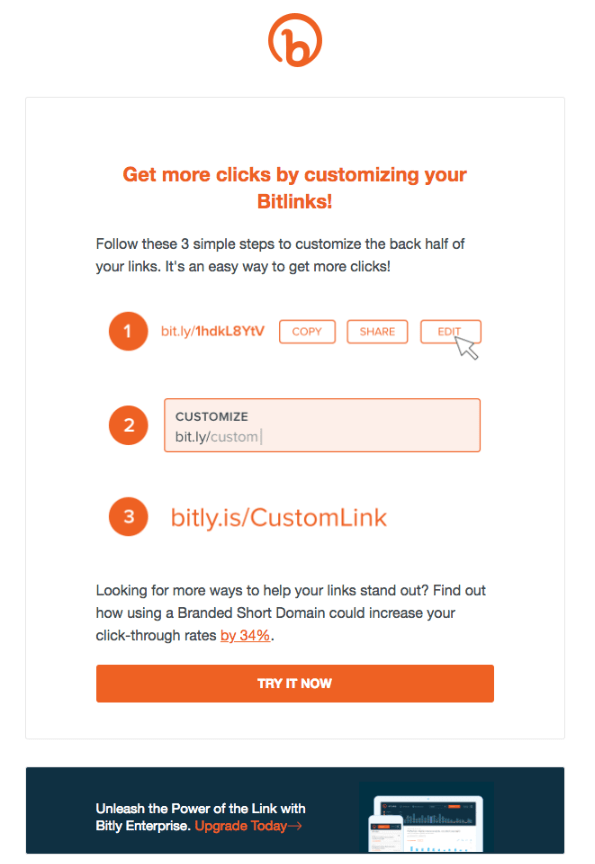
Meanwhile, this security message from Fortnite uses an eye-popping central image and subheaders to guide readers from Point A to Point B.
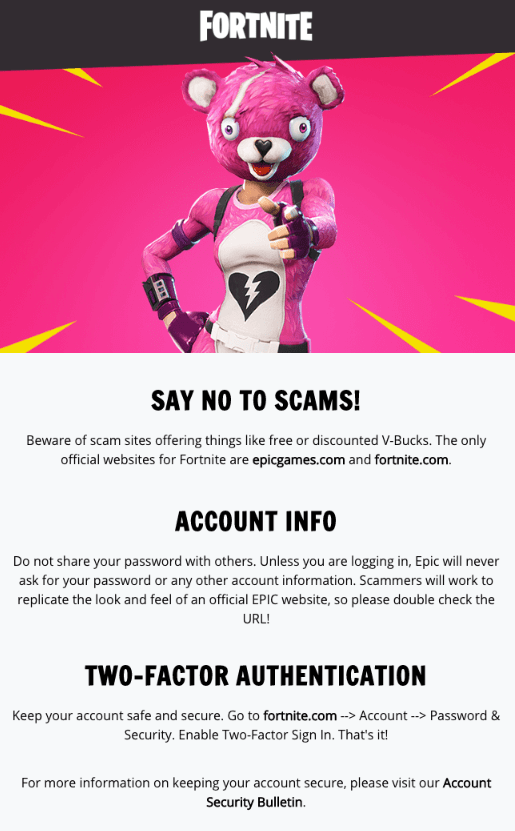
2. Hidden Call-to-Action
Whether it’s checking out an offer or answering a question, it’s your responsibility to give your readers direction. No matter what your call-to-action might be, it needs to be front-and-center rather than hidden.
Some rules of thumb regarding your calls-to-action include…
- Having multiple CTA buttons (or at least one “above the fold” of your preview)
- Providing multiple means of clicking-through, including image-based and text-based links
- Using contrasting colors to draw attention to your CTA buttons or links
This message from Via boasts crystal clear calls to action, including two buttons with contrasting colors:
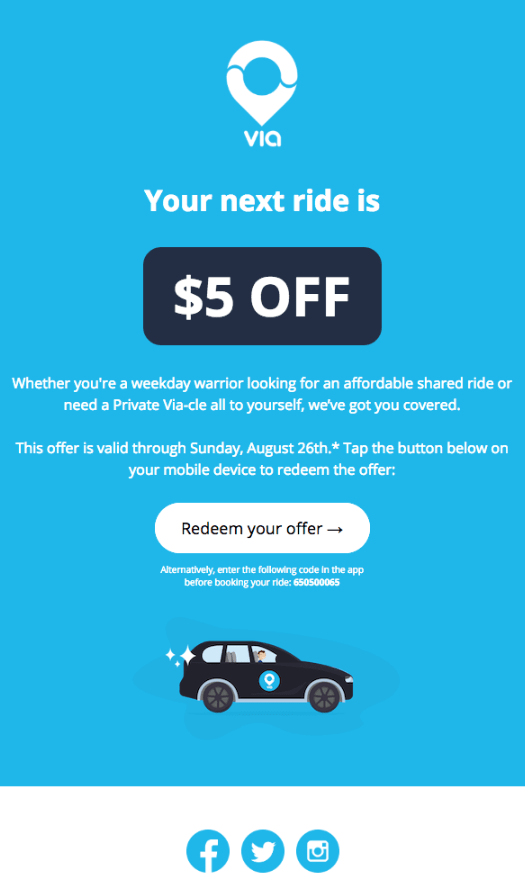
This message from Tom Raffield is pretty simple stylistically. Its 4 CTA buttons are a nice touch to encourage action.
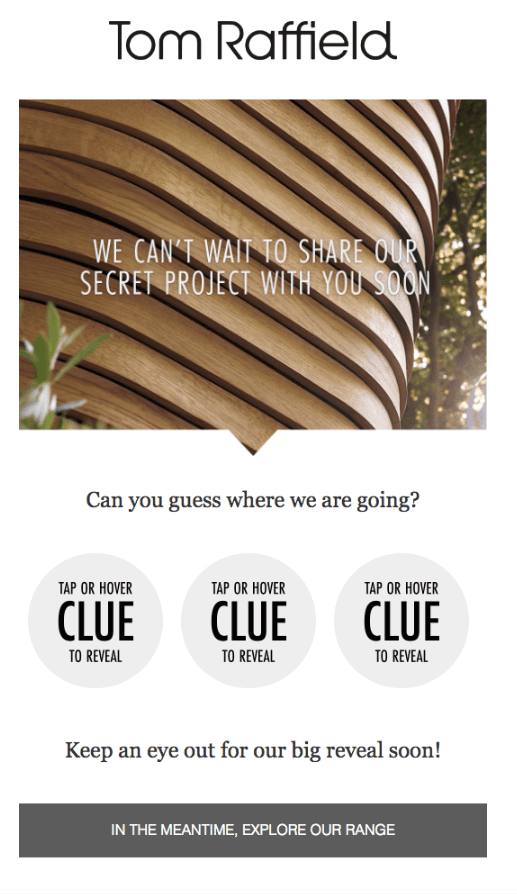
3. Failing to Test Your Messages
As rings true with any type of marketing, businesses should follow the mantra of “always test.” Consider just how many variables there are of any given marketing email.
- Subject lines
- Imagery
- Body copy
- CTA buttons
- Text links
And that’s just for starters. The specifics and placement of each of these elements could have a significant impact on your click-through rates; however, you never know until you test them.
Rather than rely exclusively on third-party testing tools, you can ideally invest in an email marketing subject that can do it for you. Through regular testing, you can fine-tune the various creative elements of your messages over time to maximize performance and engagement.
4. Poor Proofing
This might seem like a no-brainer, but you might be surprised at how many major brand emails get blasted out despite being riddled with typos and errors. But unsurprisingly, poor proofing is a surefire way to kill your credibility with readers. This is especially true if errors become a common occurrence.
Taking the time to run your email copy through tools like Grammarly or the Hemingway Editor can make all the difference. Spotting grammar errors and awkward working, both tools can give you some much-needed peace of mind before you hit “send.”
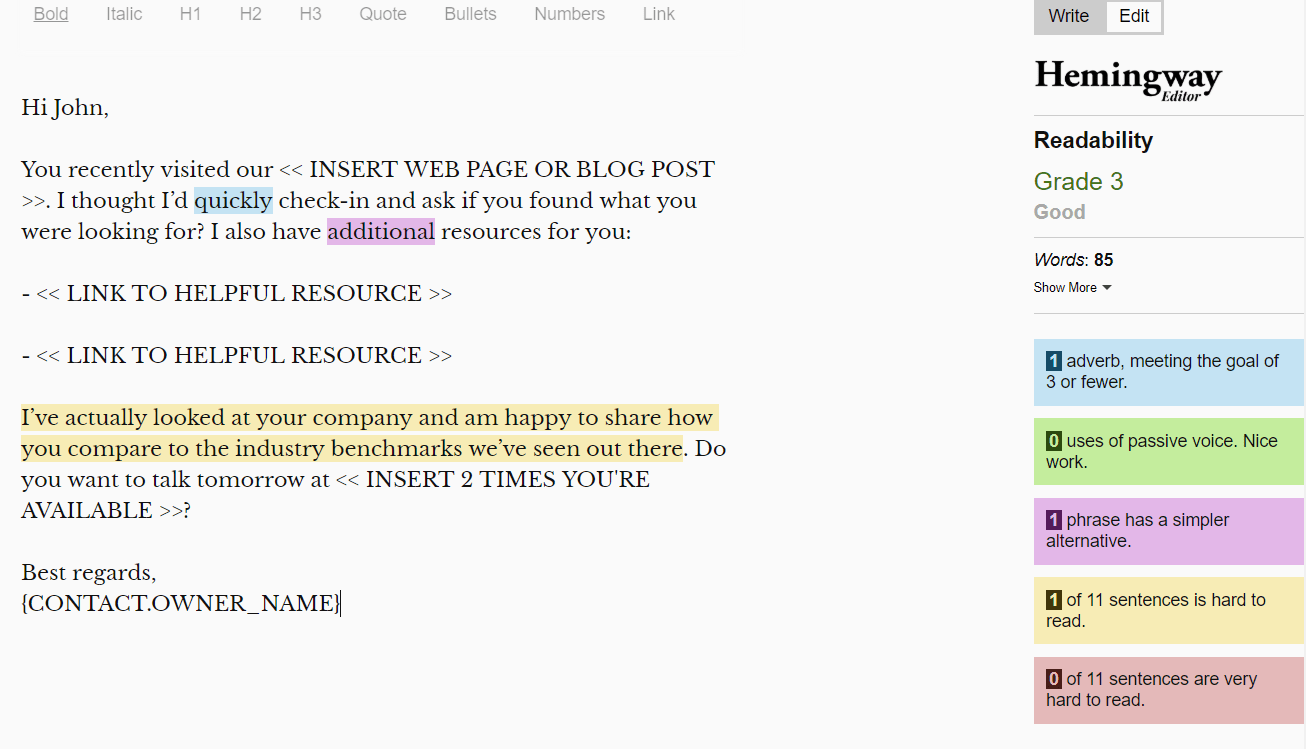
5. Unoptimized Timing
Bear in mind that your business messages are competing over 100 others in your subscribers’ inboxes on a daily basis. As a result, anything you can do to increase your potential to get seen is a plus. Optimizing your email timing is certainly a step in the right direction.
There’s the oft-cited data by MailChimp that notes weekdays are typically the way to go, with reader activity peaking on Thursdays.
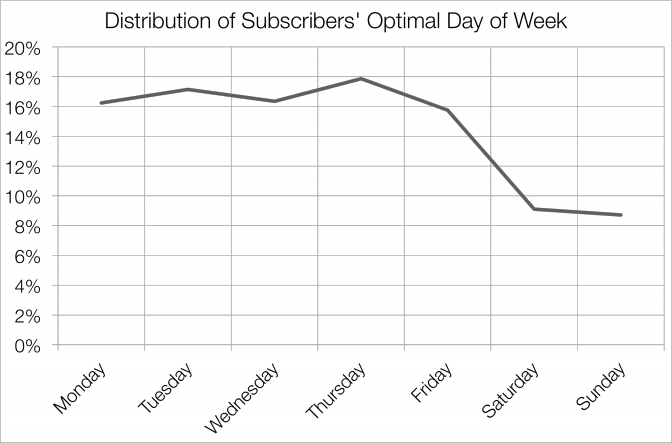
CoSchedule adds that emails can further be optimized based on the time of day they’re sent, providing specific logic for early morning, mid-afternoon, and evening send-times.
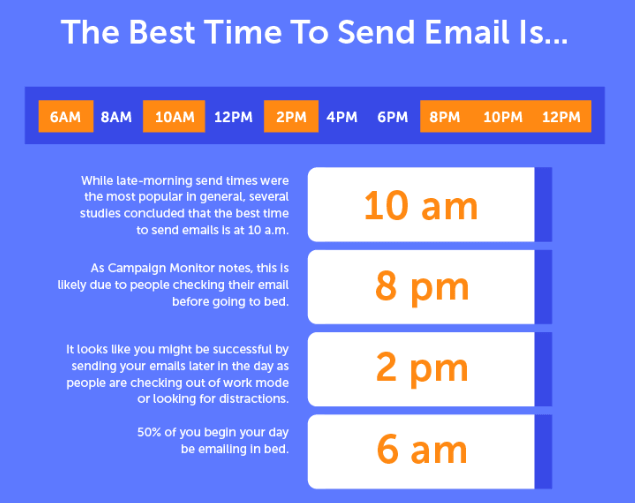
These suggestions obviously make sense as opposed to sending marketing messages over the weekends during the dead of night. The takeaway here is that there is no “right” time to send but rather to use conventional wisdom on the subject.
The good news? Most major email marketing services have an optimized timing feature that sends messages based on either industry benchmarks or real-time data of when your list is most engaged.
Why every small business should get into email marketing
Email marketing is one of the most efficient marketing channels. Email marketing has one of the highest, if not the highest return on investment (ROI) of any marketing method. How high? Up to 4400%! That means for every $1 you spend, you could potentially get $44 back from each customer. What other marketing method gives you that kind of return? We can’t think of any.
So why is email marketing so efficient? Well, for starters, almost everyone has a smartphone in their hand, and they check it all day, every day. And if you’ve built a mobile-optimized email campaign, they’ll see it, open it, and follow your call-to-action (CTA). We say mobile-optimized because some email campaigns are long-winded, and take too long to read (1 min+).
Email marketing makes the most of your marketing budget
Most small businesses have tight marketing budgets and feel like they can’t compete with the “big boys.” That’s simply not true! While you may not be able to match your competitors dollar-for-dollar, you can maximize your exposure through email marketing.
According to Matt Janaway, CEO of Marketing Labs, “The catchphrase, ‘The Money is in the list’ hits the nail on the head. Whether you’re looking to generate sales, nurture leads, stir up audience engagement, or you’re looking for audience insights, email marketing can be your go-to method. It still works like magic!”
Email marketing is a great way to reach out to customers that are interested in your brand, your service, or your products. And using a “share with your friends discount” promotion, email marketing can easily become a new source of leads without breaking the bank. Most small businesses don’t understand the necessity of email marketing and only start using it as a last resort.
The truth is … you should be using email marketing as one of your primary marketing methods. Since you may not know why we stand behind email marketing so much, we’re going to show you. Below are four reasons why a small business like yours should be using email marketing.
If you still don’t have enough business activity to justify employing a full-time email marketing professional, you also have the possibility of signing with an agency that provides this service. If you already use an agency for other marketing channels like SEO or Social media, ask them if they provide email marketing as well.
Stay Connected To Your Customers
Now we aren’t suggesting that you blast your customers with a “How are you doing today?” email every day of the week. What we are suggesting is that you need to stay in touch with them on a regular basis. Since they’ve already subscribed to your email list asking you to stay in touch, why wouldn’t you?
Essentially, they’ve asked you to contact them regarding any new products and/or services you are offering and to let them know if anything is happening (good or bad). The more you are open and honest with them, the more they’ll trust you. The more they trust you, the more they’ll be willing to talk about you with their friends and coworkers (indirect marketing; FREE).
Email Marketing Showcases Your Expertise
Having a regular email newsletter with the latest tips and advice is a great way to position your business or personal brand as a thought leader and industry expert. Sure, there are many voices and opinions out there regarding your specific field.
But, if you’ve built an email list and people have subscribed to your newsletter, then you have a captive audience who has opted in to hear your specific voice. Make the most of it by scheduling a regular newsletter with helpful content that adds value to your readers and does not try to sell them anything.
Email Marketing Creates A Brand
And finally, you create a brand when you use email marketing. How? The more you stay visible to your customers, the more memorable you become. Email marketing helps reinforce create a brand by staying in touch with your customers.
Do you have to blast them every single day? Absolutely not! On the contrary, you’ll send them away if you do that. What you have to do is find out what schedule converts the most and stick to it. Don’t overwhelm your customers, but don’t fall off the face of the earth either.
Conclusion
As you can see, email marketing can change how you reach new clients. For a small business, maximizing your marketing budget is one of the keys to your success.
Email marketing is one of the most cost-efficient marketing methods that you can use. Plus, the ROI is astronomical. And while your results may vary, there’s a good chance that you’ll at minimum double what you’ve put into your email marketing plan. Not bad for a small company that can’t compete with the “big boys”.
Email marketing is not the “telemarketers” of the internet …Your customers choose to receive email from you because they value you, your brand, your products, your services, or your expertise. Don’t waste a good opportunity to stay connected to your customers – especially when they ask for it!



